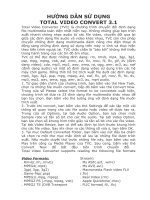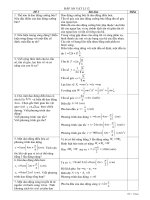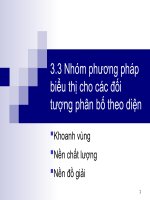Slides 3 1 calculate expected values of alternative courses
Bạn đang xem bản rút gọn của tài liệu. Xem và tải ngay bản đầy đủ của tài liệu tại đây (1.22 MB, 43 trang )
Calculate Expected Values of
Alternative Courses of Action
1
Ever had a vacation disaster?
Car trouble?
Lost luggage?
Missed flight?
Something worse?
How did that affect
your vacation
cash flows?
2
Terminal Learning Objective
• Task: Calculate Expected Values of Alternative Courses
of Action
• Condition: You are training to become an ACE with
access to ICAM course handouts, readings, and
spreadsheet tools and awareness of Operational
Environment (OE)/Contemporary Operational
Environment (COE) variables and actors
• Standard: With at least 80% accuracy:
• Define possible outcomes
• Determine cash flow value of each possible outcome
• Assign probabilities to outcomes
3
What is Expected Value?
• Recognizes that cash flows are frequently tied
to uncertain outcomes
• Example: It is difficult to plan for cost when
different performance scenarios are possible
and the cost of each is vastly different
• Expected Value represents a weighted average
cash flow of the possible outcomes
4
Applications for Expected Value
• Deciding what cash flows to use in a Net
Present Value calculation when actual cash
flows are uncertain
• Reducing multiple uncertain cash flow
outcomes to a single dollar value for a “reality
check”
• Example: cost of medical insurance
5
Expected Value Calculation
• Expected Value =
Probability of Outcome1 * Dollar Value of Outcome1
+
Probability of Outcome2 * Dollar Value of Outcome2
+
Probability of Outcome3 * Dollar Value of Outcome3
etc.
• Assumes probabilities and dollar value of
outcomes are known or can be estimated
• Probability of all outcomes must equal 100%
6
Expected Value Example
• The local youth center is running the following
fundraising promotion:
• Donors will roll a pair of dice, with the following
outcomes:
•
•
•
•
A roll of 2 (snake-eyes): The donor pays $100
A roll of 12: The donor wins $100
3 and 11: The donor pays $50
All other rolls: The donor pays $25
• Task: You are considering rolling the dice.
Calculate the expected value of your donation
7
Expected Value Example
• What are the possible outcomes?
• 2, 12, 3, 11 and everything else
• What are the cash flows associated with each
outcome?
Outcome
Cash Flow
2
-$100
12
100
3 and 11
-50
All else
-25
8
Expected Value Example
• What are the probabilities of each outcome?
Outcome
Probability
2
1/36
12
1/36
3 and 11
4/36
All else
30/36
Total
36/36
9
Expected Value Example
• Calculate Expected Value:
Outcome Probability * Cash Flow = Expected Value
2
1/36 *
-$100 =
12
1/36 *
100 =
3 and 11
4/36 *
-50 =
All else
30/36 *
-25 =
Total
36/36
• Given this expected value, will you roll the
dice?
10
Expected Value Example
• Calculate Expected Value:
Outcome Probability * Cash Flow = Expected Value
2
1/36 *
-$100 =
12
1/36 *
100 =
3 and 11
4/36 *
-50 =
All else
30/36 *
-25 =
Total
-$2.78
36/36
• Given this expected value, will you roll the
dice?
11
Expected Value Example
• Calculate Expected Value:
Outcome Probability * Cash Flow = Expected Value
2
1/36 *
-$100 =
-$2.78
12
1/36 *
100 =
2.78
3 and 11
4/36 *
-50 =
All else
30/36 *
-25 =
Total
36/36
• Given this expected value, will you roll the
dice?
12
Expected Value Example
• Calculate Expected Value:
Outcome Probability * Cash Flow = Expected Value
2
1/36 *
-$100 =
-$2.78
12
1/36 *
100 =
2.78
3 and 11
4/36 *
-50 =
-5.55
All else
30/36 *
-25 =
Total
36/36
• Given this expected value, will you roll the
dice?
13
Expected Value Example
• Calculate Expected Value:
Outcome Probability * Cash Flow = Expected Value
2
1/36 *
-$100 =
-$2.78
12
1/36 *
100 =
2.78
3 and 11
4/36 *
-50 =
-5.55
All else
30/36 *
-25 =
-20.83
Total
36/36
• Given this expected value, will you roll the
dice?
14
Expected Value Example
• Calculate Expected Value:
Outcome Probability * Cash Flow = Expected Value
2
1/36 *
-$100 =
-$2.78
12
1/36 *
100 =
2.78
3 and 11
4/36 *
-50 =
-5.55
All else
30/36 *
-25 =
-20.83
Total
36/36
-$26.38
• Given this expected value, will you roll the
dice?
15
Expected Value Example
• Calculate Expected Value:
Outcome Probability * Cash Flow = Expected Value
2
1/36 *
-$100 =
-$2.78
12
1/36 *
100 =
2.78
3 and 11
4/36 *
-50 =
-5.55
All else
30/36 *
-25 =
-20.83
Total
36/36
-$26.38
• Given this expected value, will you roll the
dice?
16
Learning Check
• What variables must be defined before
calculating Expected Value?
• What does Expected Value represent?
17
Demonstration Problem
• Sheila is playing Let’s Make a Deal and just won
$1000.
• She now has two alternative courses of action:
A) Keep the $1000
B) Trade the $1000 for a chance to choose between
three curtains:
• Behind one of the three curtains is a brand new car worth
$40,000
• Behind each of the other two curtains there is a $100 bill
• Task: Calculate the Expected Value of Sheila’s
alternative courses of action
18
Demonstration Problem
• Step 1: Define the outcomes
• Step 2: Define the probabilities of each
outcome
• Step 3: Define the cash flows associated with
each outcome
• Step 4: Calculate Expected Value
19
Define the Outcomes
Course of Action 1:
• Keep the $1,000
Course of Action 2:
• Trade $1,000 for one of the
curtains
• Two possible outcomes:
• New car
• $100 bill
20
Define the Probabilities
Keep the $1,000
• Sheila already has the
$1,000 in hand
• This is a certain event
• The probability of a certain
event is 100%
Trade $1,000 for Curtain:
Outcome
Probability
Car
$100
Total
21
Define the Probabilities
Keep the $1,000
• Sheila already has the
$1,000 in hand
• This is a certain event
• The probability of a certain
event is 100%
Trade $1,000 for Curtain:
Outcome
Probability
Car
1/3 or 33.3%
$100
2/3 or 66.7%
Total
3/3 or 100%
22
Define the Cash Flows
Keep the $1,000
• Cash flow is $1,000
Trade $1,000 for Curtain
Outcome Cash Flow
Car
$100
23
Define the Cash Flows
Keep the $1,000
• Cash flow is $1,000
Trade $1,000 for Curtain
Outcome Cash Flow
Car
$100
24
Define the Cash Flows
Keep the $1,000
• Cash flow is $1,000
Trade $1,000 for Curtain
25









